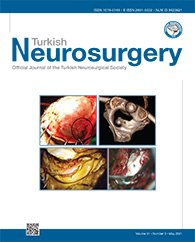2International Center for Neurosurgery, Henan Provincial People?s Hospital, Zhengzhou, China
3Atma Jaya Catholic University of Indonesia, Faculty of Medicine, Department of Surgery, Jakarta, Indonesia
4Stroke Center, Bergmannstrost Hospital Halle, Department of Neurosurgery, Halle, Germany DOI : 10.5137/1019-5149.JTN.31887-20.3 AIM: To assess the results, effectiveness, safety, and potentials of coiling and clipping of ruptured basilar apex aneurysms.
MATERIAL and METHODS: Included in this study were articles comparisons of outcomes of endovascular coiling and clipping of ruptured basilar apex aneurysms, published in the full-text form (from 1960 to March 31, 2020). Collected variables included: first author?s name, country, study period covered, publication year, the total number of patients and follow-up, the early postoperative mortality rate (PostOp-Mo) (30 days from the selecting treatment), permanent neurological deficit (PND), late mortality (LateMo) (after 1 month) and re-intervention (ReInt) (requiring surgery or coiling), for both groups. Outcomes reported by the eligible articles should be evaluated at least 6 months after subarachnoid hemorrhage or intervention (clipping or coiling).
RESULTS: After the preliminary searching, 210 articles were established to be nominees for further investigation. After the application of exclusion and inclusion criteria, there were 9 eligible articles left. The total number of patients was 582 (241 in the clipping group and 341 in coiling). Regarding PostOp-Mo, PND, and LateMo the final results demonstrated no potential significant difference between the two groups. Regarding the subgroup of patients with the ReInt the findings illustrated a statistically significant difference among the two groups [OR 2.33, CI 95%, (1.62? 3.09), Chi2=0.59 and p=0.001] with no heterogeneity (p=0.79 and I2=-69.27%).
CONCLUSION: Management complications, recurrences, and reintervention are considerably more frequent in endovascularly treated BX aneurysms.
Keywords : Basilar apex aneurysms, Basilar tip aneurysms, Intracranial aneurysms, Posterior circulation aneurysms, Clipping




